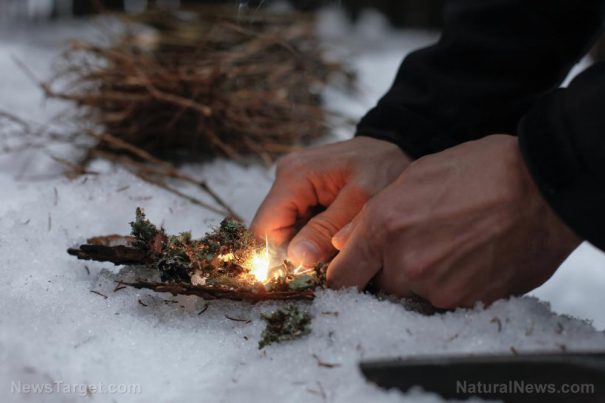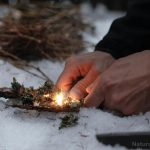
Prepping for beginners: Top 3 wilderness survival tips
Wednesday, June 07, 2023 by Zoey Sky
http://www.naturalnewstips.com/2023-06-07-prepping-beginners-top-3-wilderness-survival-tips.html

Many people like spending time outdoors to relax. But if you’re a prepper, you know that things can go wrong even when you are in a peaceful location.
Learn survival skills like how to find water, how to build a shelter and how to start a fire so you can survive while you wait for rescue if you get lost in the wilderness. (h/t to PreppersSurvive.com)
If you get lost while hiking or camping, these will help improve your chances of survival if you are separated from your group.
Finding a water source and purifying water
To ensure that you survive in the wilderness, you must learn how to find water and how to purify it using tools from your survival bag or things you can find around you.
Depending on how long your hike is, you’re unlikely to carry enough water so you can stay hydrated for several days.
If you’re sitting at a desk in your office, you will be fine with drinking only four to six cups of water per day. However, your hydration needs will vary in the wild, especially if you are exerting yourself with physically demanding tasks like hauling firewood and building a shelter.
If you are lost in the mountains, you are lucky because mountain ecosystems provide 85 percent of the water most municipal systems depend on. You just need a reliable way of finding and purifying water.
If you want to find the cleanest source of water in the wild, look for running water and groundwater. These are the most common water sources in the wild, and you can often find them in valleys, ravines and other low points due to gravity.
The faster the water is flowing, the better when it comes to cleanliness. This means you should prioritize running sources over groundwater.
Tips for finding water in the mountains
If you get lost in a mountainous area, follow these tips to find water:
- Gravity is your friend after it rains because water will often collect in mountain bases. If you’re lucky, you might find a spring. If not, dig down several inches to find water in the wilderness.
- If it doesn’t rain, search for a game trail and follow it. Animals also get thirsty, and you can track them by observing broken limbs and trampled foliage. Follow the trail to a water source.
- You can also find water by looking for plants, which also need water to survive. If you see a patch of dark green when the rest of the landscape is brown, search in that direction.
If these methods don’t work for you, harvest rainwater by gathering dew off plants or making a solar still.
Gather dew by placing large leaves in cheesecloth and squeezing and emptying the water you gathered into your water container.
To build a solar still, follow the steps below:
- Dig a hole about three feet by four feet.
- Dig a smaller hole inside the first hole, then place your water container inside the smaller hole.
- Add vegetation to increase moisture in the still without putting it in the container.
- Cover the hole with a plastic sheet. Place large rocks along the outside edge and a smaller one in the center. This will create a dip so the water flows into the container after collecting on the bottom side of the plastic.
- Wait 24 to 48 hours. If you are already thirsty, rest in the shade while you wait.
Water purification tips
There are different water purification methods, but not all of them are foolproof. To avoid getting sick after drinking dirty water, combine at least two to three of these methods:
Boiling water. This old water purification method is a trusted one because it’s simple and it helps kill various organisms. When you’re done, the fire will also help you stay warm.
Chemical purification. If you have water purification tablets in your gear, keep in mind that you need to wait for about 35 minutes before the purification process is complete.
Filtering layers. Activated charcoal is a popular filtering layer method. If you don’t have activated charcoal, use a clean piece of cloth or screens to filter particulates. This method takes some practice, so practice it at home so you know what to do when SHTF.
Survival water straw. Depending on which water straw you buy, it can remove bacteria, like cholera, E. coli and salmonella, or parasites, such as giardia and cryptosporidium, from the water you harvest in the wild. Most water straw designs are lightweight and simple to use.
Building a shelter
If you think you might have to spend the night in the woods, settle down in a safe location and build a shelter. Here are four simple ways to build a primitive shelter for survival in the wilderness:
A-frame shelter
If you can find a branch that looks like a large “Y,” stick the bottom in the ground.
Place another stick in the crack with the end descending to the ground and build up both sides, using the same technique you’d use to build a teepee (see tips below).
Dug-out shelter
A dug-out shelter is very cozy, but it takes the most energy to build because you have to dig.
Find soft dirt near a cliff’s face, then hollow out a small cave if you can. Otherwise, dig into the earth and cover the top with a tarp or branches and leaves.
Tarp
Use a sturdy stick to prop one end of the tarp open as an entrance.
Use rocks or string to secure the other edges of the tarp over you so you can stay dry and rest.
Teepee
Select a sturdy tree and prop long, large branches against it to create the frame.
Cover the outside with smaller twigs, then place a layer of leaves and other debris to block the wind.
Since you are trying to survive in the wilderness, you should conserve your energy and keep the shelter small but still comfortable to rest and sleep in. The smaller you keep the shelter, the better your body heat will keep it warm.
Warmth/fire starting
Fire starting is an important survival skill, especially when you are lost in the mountains.
Here are techniques and tools that will make it easier to start a fire:
Lighters and matches
Lighters and matches are two of the easiest methods to use for fire starting, so keep them in your survival bag.
Keep them dry by wrapping them in plastic and storing them in a waterproof container.
Steel flint
Flint and steel fire starters are often included in some survival kits. If you wear a paracord bracelet, check it because it might have one attached.
Flint and steel firestarters are ideal if you need something reliable and waterproof.
Steel wool and battery
This option might seem unusual, but if you keep steel wool and a nine-volt battery in your fire starting kit, rubbing the nodes of the battery with the wool create sparks you can add kindling to start a fire.
Bow drill
Lighters and flint and steel are great fire starters, but you should also learn how to start a fire using simple methods like a bow drill.
If you only have a bit of string in your pocket, use it to make a primitive bow drill and a fireboard.
However, this method takes skill and practice, so try it at home and keep practicing until you are confident about using a bow drill to start a fire.
Extra supplies for your survival bag
Having these items in your survival bag can help increase your chances of making it home in one piece.
Food
You can survive much longer without food than without water, but you can also carry snacks in your bag so you don’t starve when SHTF.
Here are some of the best bug-out bag snacks:
- Crackers
- Lentils
- Nuts
- Peanut butter
- Raisins
- Seeds
- Tuna and salmon pouches
To keep your bag light, learn how to hunt and forage to supplement your diet.
If you go hiking or camping frequently, learn which edible plants grow in your area and how to prepare them if they aren’t edible raw. (Related: Survival essentials: How to prepare an efficient fishing kit.)
Medical care
Getting injured in the wild can decrease your survival chances, so make sure you have a well-stocked first-aid kit in your bag.
Clean infected cuts with bandages and antibiotic ointment.
Protection
Bring a weapon that you know how to use properly, like a firearm or bear spray, so you can protect yourself when SHTF. Practice regularly with your firearm of choice.
Before you go hiking or camping, prepare for your trip. This means giving someone you trust your itinerary. If you don’t check in regularly, they will know that something bad has happened and they can call for help so you don’t have to wait long if you are lost or injured.
Double-check your bag before the trip. Make sure you have snacks, firestarting tools and a first aid kit.
Watch the video below for tips on how to start a fire in the rain and wet weather.
This video is from the Survival 101 channel on Brighteon.com.
More related stories:
Prepper fitness: Why is physical health important for survival?
Prepare before SHTF by learning how to manage first aid emergencies in austere environments.
Ways to develop mental toughness and a survivor mindset when SHTF.
Sources include:
Tagged Under: Tags: bug out, firestarting, Gear, how-to, off grid, preparedness, prepper, prepping, self sufficiency, shelter, SHTF, survival, survival gear, survival skills, survivalist, tips, warmth, water, wilderness survival
RECENT ARTICLES


Prepping for beginners: Top 3 wilderness survival tips
By Zoey Sky

Essential items every prepper should have in their bug-out bag
By Olivia Cook

Big Pharma’s favorite customers: 60% of American adults have at least one chronic condition and 40% have more than one
By Olivia Cook

Michelle Obama’s juice brand fails health standards set by her husband’s administration
By Zoey Sky
COPYRIGHT © 2017 NATURAL NEWS TIPS


